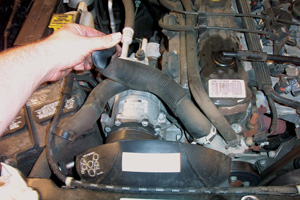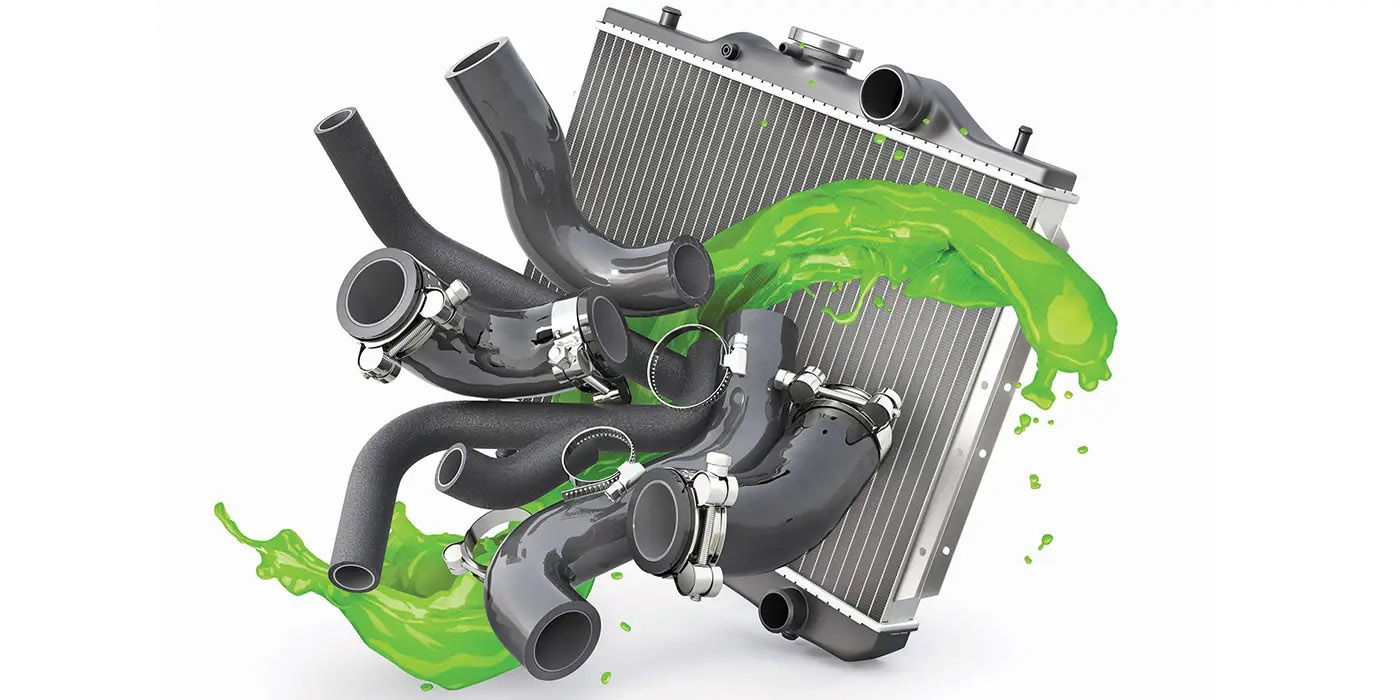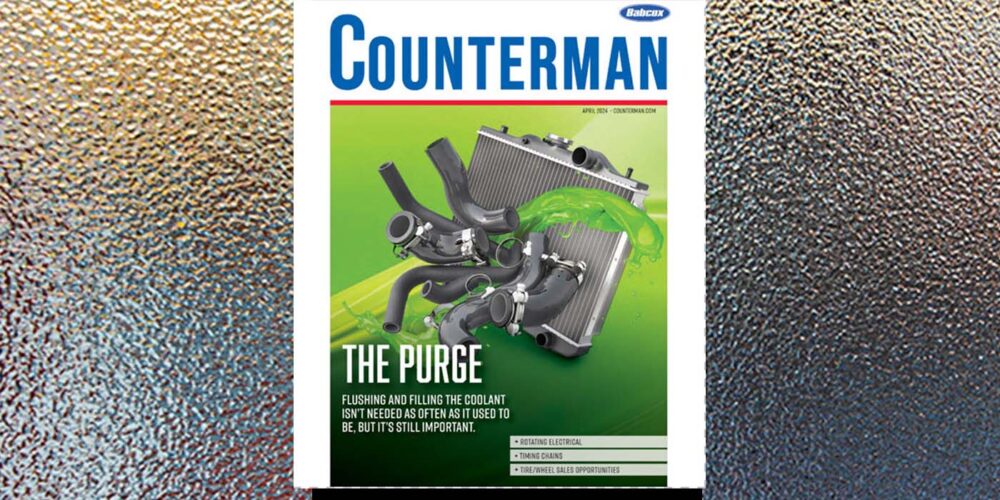The cooling system’s job is to manage heat produced by the engine, to help the engine warm up quickly and maintain a consistent operating temperature and provide heat for the heater.
 ● COOLANT — A mixture of water and antifreeze circulates inside the engine and radiator. There are two basic types of antifreeze: ethylene glycol (EG), which is the most common, and propylene glycol (PG), which is less toxic to animals. Antifreeze is usually mixed in equal parts (50/50 mix) with water. With EG antifreeze, this provides freezing protection down to -34 degrees F and boilover protection up to 265 degrees F with a 15 PSI radiator cap.
● COOLANT — A mixture of water and antifreeze circulates inside the engine and radiator. There are two basic types of antifreeze: ethylene glycol (EG), which is the most common, and propylene glycol (PG), which is less toxic to animals. Antifreeze is usually mixed in equal parts (50/50 mix) with water. With EG antifreeze, this provides freezing protection down to -34 degrees F and boilover protection up to 265 degrees F with a 15 PSI radiator cap.
Coolant needs to be changed periodically to renew the chemical additives that protect the cooling system against corrosion. The recommended change interval for traditional antifreeze (green and yellow) is two years/30,000 miles, and up to five years or 150,000 miles (whichever comes first) for long-life coolants.
Vehicle manufacturers use long-life coolants to reduce maintenance. Corrosion inhibiting additives and colors can vary depending on the application and model year. GM has used an orange colored coolant called Dex-Cool since 1996. Dex-Cool contains “Organic Acid Technology”(OAT) inhibitors. Since 2002, Ford has been using a yellow-colored “Hybrid Organic Acid Technology” (HOAT) formula with silicates, but is not switching some models over to OAT coolants. Chrysler has its own HOAT formula coolant called G-05, which is dyed orange like Dex-Cool but is different. Asian and European automakers also have their own formulas and colors.
As long as a vehicle is under warranty, a coolant should be used that meets the vehicle manufacturer’s specifications. Universal “all makes all models” coolants also are available, and are safe to use in most vehicles although the formula may vary from the original. Ordinary green antifreeze should not be mixed with long-life coolants as doing so will shorten the service life of the coolant.
Rust, scale and sediment can be removed from a cooling system by using a chemical cleaner and reverse flushing the system when the coolant is changed. Leaks can be prevented, and small leaks can often be sealed, by adding a sealer product to the coolant.
● THERMOSTAT – Controls the operating temperature of the engine by restricting the flow of coolant between the radiator and engine. It is usually located in a housing where the upper radiator hose attaches to the engine, but on some engines may be located elsewhere.
The thermostat blocks the flow of coolant until the engine reaches a certain temperature (typically 195 to 210 degrees). This speeds engine warm-up and reduces emissions.
Thermostat failures are a common cause of overheating. Replacement thermostats must be the same temperature rating as the original. This is extremely important on late model computer-controlled engines that use the temperature reading from the coolant sensor to regulate the fuel mixture, ignition and other emission functions. Some vehicles have thermostats with a “jiggle pin” vent that allows trapped air to escape from the engine when the cooling system is refilled with coolant.
● WATER PUMP — A belt-driven pump that circulates coolant between the engine and radiator. The pump consists of a steel or plastic impeller mounted on a shaft inside a cast or stamped steel housing. Failure of the pump shaft seal or bearing can cause noise and coolant leaks. A defective water pump can be replaced with a new or remanufactured replacement pump.
● RADIATOR — A large heat exchanger mounted in front of the engine. Airflow through the radiator provides cooling for the coolant that circulates through it. Most newer radiators are a “crossflow” design where the coolant flows from one end to the other. Older vehicles usually have “downflow” radiators where the coolant flows from the top to the bottom. Most late model radiators are aluminum while many older radiators are copper/brass. Most radiators also contain a loop of pipe in the bottom tank or end tank for cooling automatic transmission fluid. A replacement radiator should have the same hose configuration (location and size) as the original, and provide equivalent (or better) cooling. For towing applications and high-performance engines, a larger, thicker and/or more efficient radiator can be installed to improve cooling.
● RADIATOR CAP — A spring-loaded pressurized cap on the radiator that prevents coolant loss and increases the temperature at which the coolant boils. Pressure ratings vary from 5 to 15 psi. A weak radiator cap may allow the engine to overheat or lose coolant. Caps should be replaced if they do not seal properly or hold their rated pressure. Replacement caps must have the correct pressure rating for the application to prevent overheating.
● COOLING FAN — Most late model vehicles use an electric cooling van, while older vehicles typically have a belt-driven fan. A few vehicles have hydraulic fans that are driven by power steering fluid. The fan increases airflow through the radiator for improved low -speed cooling. Belt-driven fans are mounted on the water pump pulley, and may have a viscous clutch that allows the fan to slip at higher speeds when extra cooling isn’t needed. Electric fans may be mounted in front or behind the radiator, and are powered through a relay. Some vehicles have a temperature switch to turn the fan on and off, while others use commands from the engine computer and coolant sensor or a control module to run the fan. Some vehicles have two electric fans, one of which may be used for the A/C condenser. A fan or fan clutch failure may cause the engine to overheat at low speed.
● COOLANT SENSOR — Monitors the temperature of the coolant. The sensor’s resistance changes with the temperature of the coolant. The sensor’s output voltage may be used to operate a temperature gauge or warning light, the cooling fan and various emission functions. It is also used by the engine computer to determine when the engine can go into “closed loop” operation (when the computer uses input from the oxygen sensor to regulate the fuel mixture). A defective sensor can prevent the engine from going into closed loop, cause poor fuel economy and higher emissions.
● RADIATOR & HEATER HOSES — Flexible rubber hoses that carry coolant between the engine, radiator and heater core. Most applications have an upper radiator hose, a lower radiator hose and at least two heater hoses. There may be an additional bypass hose or other connecting hoses. Some newer vehicles have “branched hoses” where one hose connects directly to another. Most original equipment hose is “molded” to shape, while some aftermarket replacement hose is “flex” hose that bends and can be used in a wider variety of applications. Hoses deteriorate with age and may leak, allowing loss of coolant and engine overheating. Replacement hoses must be the same diameter and length as the original. Always recommend new clamps.
● BELTS — V-belts haven’t been used for decades, but they may still be needed for older vehicle applications. Most late model vehicles use a single serpentine belt to drive the water pump and other engine accessories, though some may have more than one belt or use a special type of “Stretch-Fit” belt that has no tensioner or adjustments.
Belts deteriorate with age, and should be replaced if frayed, cracked, glazed or oil-soaked. Serpentine belts made of EPDM usually do not crack with age, and have a service life of up to 100,000 miles or more. But the grooves in the belt can become worn allowing the belt to slip. Replacement belt length and width must be the same as the original.
On vehicles with serpentine belts, the automatic tensioner may also need to be replaced if it is sticking, making noise or cannot maintain proper belt tension. Belt idler pulleys should also be replaced if noisy, worn or sticking.
Ignition System
Manual Transmission/Transaxle Parts
Emission Controls
Driveline Components










